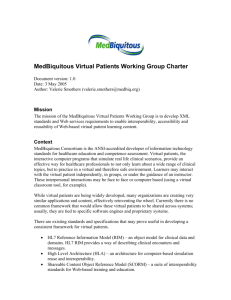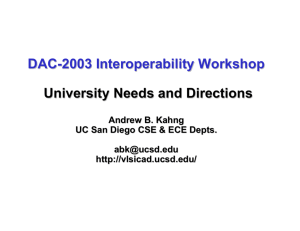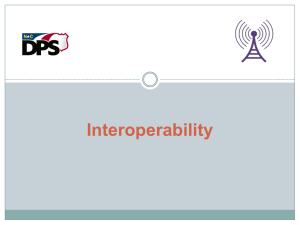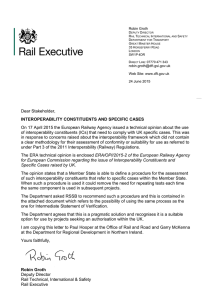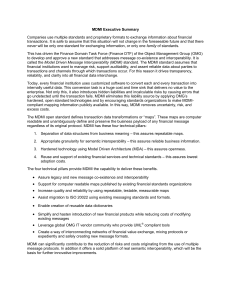Healthcare What providers can do to make IT systems communicate better
advertisement
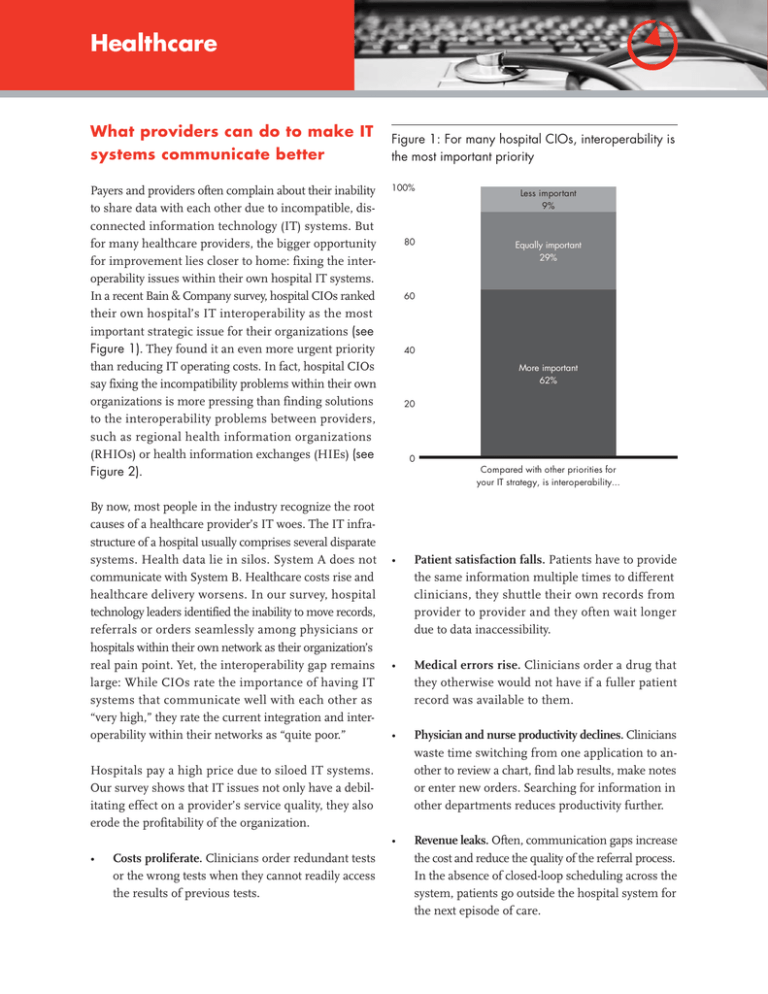
Healthcare What providers can do to make IT systems communicate better Payers and providers often complain about their inability to share data with each other due to incompatible, disconnected information technology (IT) systems. But for many healthcare providers, the bigger opportunity for improvement lies closer to home: fixing the interoperability issues within their own hospital IT systems. In a recent Bain & Company survey, hospital CIOs ranked their own hospital’s IT interoperability as the most important strategic issue for their organizations (see Figure 1). They found it an even more urgent priority than reducing IT operating costs. In fact, hospital CIOs say fixing the incompatibility problems within their own organizations is more pressing than finding solutions to the interoperability problems between providers, such as regional health information organizations (RHIOs) or health information exchanges (HIEs) (see Figure 2). By now, most people in the industry recognize the root causes of a healthcare provider’s IT woes. The IT infrastructure of a hospital usually comprises several disparate systems. Health data lie in silos. System A does not communicate with System B. Healthcare costs rise and healthcare delivery worsens. In our survey, hospital technology leaders identified the inability to move records, referrals or orders seamlessly among physicians or hospitals within their own network as their organization’s real pain point. Yet, the interoperability gap remains large: While CIOs rate the importance of having IT systems that communicate well with each other as “very high,” they rate the current integration and interoperability within their networks as “quite poor.” Figure 1: For many hospital CIOs, interoperability is the most important priority 100% 80 Costs proliferate. Clinicians order redundant tests or the wrong tests when they cannot readily access the results of previous tests. Equally important 29% 60 40 More important 62% 20 0 Compared with other priorities for your IT strategy, is interoperability... • Patient satisfaction falls. Patients have to provide the same information multiple times to different clinicians, they shuttle their own records from provider to provider and they often wait longer due to data inaccessibility. • Medical errors rise. Clinicians order a drug that they otherwise would not have if a fuller patient record was available to them. • Physician and nurse productivity declines. Clinicians waste time switching from one application to another to review a chart, find lab results, make notes or enter new orders. Searching for information in other departments reduces productivity further. • Revenue leaks. Often, communication gaps increase the cost and reduce the quality of the referral process. In the absence of closed-loop scheduling across the system, patients go outside the hospital system for the next episode of care. Hospitals pay a high price due to siloed IT systems. Our survey shows that IT issues not only have a debilitating effect on a provider’s service quality, they also erode the profitability of the organization. • Less important 9% Figure 2: Hospitals rate their internal interoperability issues as more pressing than interoperability within the network For each of the following areas, please rate: The importance of having interoperability (1 – Not important; 10 – Mission critical) The current level of interoperability (1 – No communication; 10 – Fully integrated) Rating 10 8.6 9.1 9.3 8.6 8.1 8 5.8 6 5.7 4.8 4 2 Current level 0 Importance Between backoffice systems Between clinical IT systems Across hospital depts With innetwork hospitals With innetwork physicians Rebooting healthcare IT The symptoms might vary, but in our experience a few chronic maladies cause the majority of interoperability problems in hospitals. For starters, providers tend to make decisions on information technology investments based on “best of breed” vendors for each IT application. Multiple IT vendors proliferate within a facility, sowing the seeds for future interoperability mismatches. Then healthcare innovations—such as the rise of consumerdriven health plans (CDHPs)—create the need for new information. As hospitals scramble to meet demands, interoperability gaps develop. Frequently, hospitals are trapped in legacy systems: The introduction of new technologies results in a constant cycle of software upgrades. Over the last decade, mergers and acquisitions among hospitals further compounded interoperability by bringing very different software infrastructure under the same roof. Finally, the fact that major healthcare software vendors have not aligned around a set of software standards further complicates matters. With hospital systems With a state HIE With the NHIN Recently, the US government established a set of incentives designed to break down these silos. Currently, billions of dollars, funded in part by US tax revenues, is flowing toward IT solutions that enable disparate healthcare entities—payer to provider and provider to provider—to pass data seamlessly among one another. • The Nationwide Health Information Network provides a framework for secure health information exchange over the Internet. In 2004, the Office of the National Coordinator (ONC) of Health Information Technology was chartered to oversee and coordinate the nationwide effort to “use the most advanced health information technology and the 1 electronic exchange of health information.” • The American Recovery and Reinvestment Act allocated billions of dollars in the form of Medicare and Medicaid incentives to encourage providers to install electronic health records (EHR) technology. The act also set aside substantial funds to develop HIEs that allow payers and providers to share data and improve interoperability among healthcare systems. • The US Department of Health and Human Services’ recommendations on the meaningful use of EHRs place a strong emphasis on providers’ ability to exchange information in order to receive incentives from the federal government. This period marks a new growth phase in healthcare IT, spurred to a large extent by government investment. These investments will allow providers that have remained out of the EHR conversation so far—smaller hospitals and physicians’ groups, for example—to catch up with the state of the art in healthcare IT. These dollars will also benefit vendors of EHR, computerized physician order entry (CPOE), electronic prescribing and other solutions that qualify for stimulus funding. Not surprisingly, vendors are investing heavily to make their solutions easier to install and to integrate as seamlessly as possible with the client’s existing systems. However, healthcare CIOs know that in the short term, installation of an EHR system will add a great deal of additional complexity and raise a new set of interoperability issues to conquer. In recent years a new category of software solutions— interoperability platforms—have grown at impressive rates. Designed to solve the incompatibility issues providers face, these solutions offer an alternative to the wholesale replacement of the patchwork quilt of systems from multiple vendors—a multiyear process that many hospital executives consider operationally risky as well as expensive. Instead, the integrated platforms from a single vendor offer flexible software architecture: They allow data from multiple systems to be mapped to an integration engine. That means hospital IT systems can easily aggregate and manipulate data across the various applications. Many of these solutions also allow Web-based viewers at the point of care to see a comprehensive view of the patient’s medical history. Smart integration platforms don’t replace the current architecture, but run in parallel with a hospital’s core systems. They ensure that providers have all the data they need, when they need it, in the formats they prefer. The path to interoperability Bain & Company estimates that hospital CIOs plan to double their spending on interoperability solutions over the next five years. Their big concern: understanding where value leaks away from their current IT architecture and how to plug the leaks. In follow-up interviews, many CIOs could not pinpoint where and why their systems fell short on performance. Even among those who had a long list of development projects to address interoperability issues, few felt they knew exactly how to extract greater value by getting systems to communicate effectively. In our experience, hospital CIOs and CFOs who want to identify the gaps and track them much more closely can begin by asking the following questions: • Can referrals be scheduled easily across departments or sites of care? Are revenues lost because patients are expected to schedule follow-up and referral appointments on their own? • Are all the relevant clinical data for any individual patient—including those from the referring physician—available to the appropriate clinicians? What data is missing, and why? • How often are duplicate tests ordered? Why? • Do clinicians complain about awkward work flows as a result of the chosen software solutions? Do they have to jump across multiple applications or interfaces to complete a task? • Are Health Insurance Portability and Accountability Act (HIPAA) security concerns addressed without onerous processes or procedures? Can clinicians access the appropriate data with a single sign-on? • Does the transfer of information from one department to another, or from one site of care to another, result in the denial of claims for some services, or delays in payment? When CIOs step back and review the costs of poor system interoperability, they get a better understanding of how to make all IT development projects more effective. While the specific approach depends on a hospital’s IT systems and strategy, in our experience many hospitals can quickly take some clear, practical actions: Identify the root causes of interoperability and group the issues logically: A full accounting of interoperability issues may turn up dozens of root causes. But as long as these are treated as discrete, individual problems, few of them will be significant enough to rise to the top of the CIO’s IT project list. A better approach: Group the issues into relevant buckets, either by the core business process that’s impacted, the underlying software solutions most affected or (and this is rare) in terms of the department or entity impacted. Assess the costs of poor interoperability: Executives should make an effort to enumerate the costs of their poor system interoperability. The approach should be to identify the orders of magnitude, rather than pursue precision, which can be time-consuming and tedious. At this stage, the objective is to identify root causes and to determine broadly how significant these issues are, rather than working on a detailed return on investment (ROI). Once a CIO assigns values to each of the logical groups of issues identified, the priorities become clearer. 1 For the highest-order issues, for example, the CIO would assess the options for fixing them and compute the ROI—or whatever metrics the organization uses to establish the IT project portfolio. Reassess the development portfolio: In our experience, interoperability fixes frequently offer very attractive ROIs. More often than not, we find that some of these logical groups rise to the very top of a CIO’s IT project list. Instead of solving discrete interoperability issues as they surface, such an approach allows a CIO to see where value is leaking from the organization and focus resources on closing the gaps. When hospital senior executives get a full measure of the value they can generate, addressing interoperability gaps becomes not just a top strategic priority to offer patients better healthcare—but also a smart way to manage a hospital’s financial health. http://healthit.hhs.gov/portal/server.pt/community/healthit_hhs_gov__onc/1200. Key contacts in Bain’s Global Healthcare practice are: Americas: Dale Stafford in Atlanta (dale.stafford@bain.com) David Bellaire in Atlanta (david.bellaire@bain.com) Kara Murphy in Boston (kara.murphy@bain.com) Asia: Phil Leung in Shanghai (philip.leung@bain.com) Hirotaka Yabuki in Tokyo (hirotaka.yabuki@bain.com) Europe: Michael Kunst in Munich (michael.kunst@bain.com) For additional information, please visit www.bain.com


